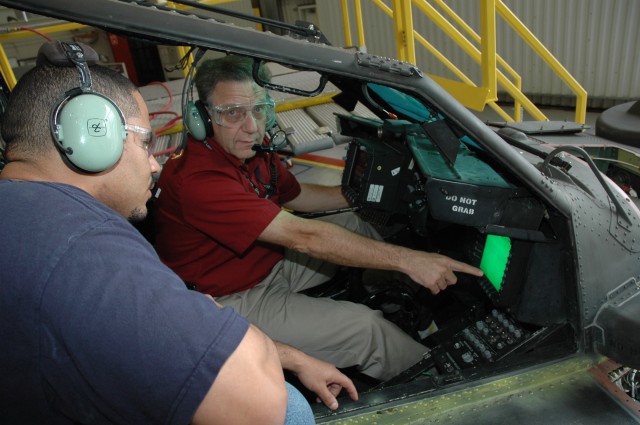Corpus Christi Army Depot, Tx. - An exciting upgrade arrived at Corpus Christi Army Depot recently, marking a revolution in attack helicopters within the past five years.
An AH-64 Apache, equipped with a new sighting and targeting system, caused a bit of a stir in the Directorate of Aircraft Production as CCAD employees tested the technological marvel.
This is the first Modernized Target Acquisition Designation Sight/Pilot Night Vision Sensor installation completing Crash Damage Overhaul at the depot. Corpus Christi Army Depot, located in South Texas, specializes in helicopters seeking overhaul, maintenance, and repair. Previously, all Apaches getting serviced at CCAD came with the older sighting system, Target Acquisition Designation Sight/Pilot Night Vision Sensor. The MTADS was delivered to CCAD where installation and operation training was conducted and signed off.
David Tanner was the work leader in the MTADS installation effort. He identified several key things they do to this new equipment before sending it back to the warfighter: "We install it and perform the operational checks of the system. We also maintain it and troubleshoot any problems that the system might have all the way through the build process and flight test stage."
Designed for safe flight in day, night, or bad weather missions, its visionics design is truly impressive, being considered the most advanced targeting and piloting system on Apache helicopters. The system is comprised of two separate subsystems: one for targeting and one for pilotage. MTADS is replacing the legacy system, TADS/PNVS.
"The old TADS was like looking thru vision with cataracts and now it's clear and modern. The gunner pilot can see enemies better and be real effective covering a convoy," mentions Larry Simone, Director of Aircraft Production.
The system offers digital video and a flat-panel display for enhanced tracking and recording. It also offers forward-looking infrared or FLIR sensors to help pilots avoid low obstacles like wires and trees.
Side-by-side, the two generations of sighting and targeting systems are drastically different. The first generation, TADS, offers a grainy image which would have been decent for past decades but, with modern technology being what it is, leaves it wanting. MTADS, the second generation, is more akin to what we see with modern television and with our own eyes - a clear and smooth image uncomplicated by technological setbacks.
"The new MTADS system allows for better targeting and tracking, giving the crew a better chance at identifying friendly forces from the enemy. It makes the ground fighter feel safer when these aircraft are in the air giving them support. It has also improved the night vision FLIR, allowing the pilots better vision when flying at night and has made flight safer for the crew because they are able to see better and identify hazards easier," notes David Tanner.
Clearly excited to have such impressive and new equipment in the hangar, Simone concludes, "It's just a big fantastic upgrade to an old system."




Social Sharing